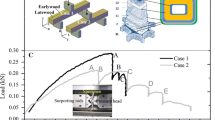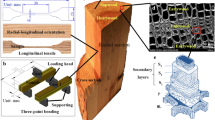Summary
Structural changes in spruce and aspen wood samples subjected to axial compression were examined by means of the scanning electron microscope. For comparison, macroscopic model experiments were carried out on tube-shaped samples made of paper so as to represent segments of fibriform xylem cells. The results show that there are fracture patterns characteristic of wood in general and others characteristic of the species of wood. The phenomena characteristic of wood in general are prevalent at the cellular level and in the fracture behaviour of the cell wall layers and perforations. The characteristics of the various species of wood dominate at the level of the growth rings and are decisively influenced by the composition and arrangement of the tissues. The model experiments show that the failure morphology of the individual cells of the xylem may be explained to some extent by their geometry.
Similar content being viewed by others
References
Borgin, K.; Parameswaran, N.; Liese, W. 1975: The effect of aging on the ultrastructure of wood. Wood Sci. Technol. 9: 87–98
Debaise, G. R.; Porter, A. W.; Pentoney, R. E. 1966: Morphology and mechanics of wood fracture Mater. Res. Stand. 6: 493–499
Delorme, A.; Verhoff, S. 1975: Zellwanddeformationen in sturmgeschädigtem Fichtenholz unter dem Rasterelektronenmikroskop. Holz Roh-Werkst. 33: 456–460
Dinwoodie, J. M. 1968: Failure in timber. Part 1: Microscopic changes in cell wall structure associated with compression failure. J. Inst. Wood Sci. 4: 37–53
Dinwoodie, J. M. 1975: Timber — a review of the structure — mechanical property relationship. J. Microsc. 104: 3–32
Ellenberg, H.; Klötzli, F. 1972: Waldgesellschaften und Waldstandorte der Schweiz. Mitteilung. Eidg. Anstalt f. d. forstl. Versuchswesen. 48: 591–868
Exley, R. R.; Butterfield, B. G.; Meylan, B. A. 1974: Preparation of wood specimens for the scaning electron microscope. J. Microsc. 101: 21–30
Frey-Wyssling, A. 1953: Über den Feinbau der Stauchlinien in überbeanspruchtem Holz. Holz Roh-Werkstoff 11: 283–288
Grossmann, P. U. A. 1974: The role of the botanical structure of wood in the fracture process. In: Proceedings of the Australian Fracture Group Conference, Melbourne: 51–57
Grossmann, P. U. A.; Wold, M. B. 1971: Compression fracture of wood parallel to the grain. Wood Sci. Technol. 5: 147–156
Jeronimidis, G. 1976: The fracture of wood in relation to its structure. Leiden Bot. Ser. 3: 253–265
Keith, C. T. 1971: The anatomy of compression failure in relation to creep-inducing stresses. Wood Sci. 4: 71–82
Keith, C. T. 1974: Longitudinal compressive creep and failure development in white spruce compression wood. Wood Sci. 7: 1–12
Keith, C. T.; Côté W. A. Jr. 1968: Microscopic characterization of slip lines and compression failures in wood cell walls. For. Prod. J. 18: 67–74
Kisser, J.; Steininger, A. 1952: Makroskopische und mikroskopische Strukturänderungen bei der Biegebeanspruchung von Holz. Holz Roh-Werkstoff 10: 415–421
Kitahara, R.; Tsutsumi, J.; Matsumoto, T. 1981: Observations on cell wall response and mechanical behaviour in wood subjected to repeated static bending load. Mokuzai Gakkaishi 27: 1–7
Kučera, L. J. 1981: Cutting wood specimens for observations in the scanning electron microscope. J. Microsc. 124: 319–325
Ohsawa, J.; Yoneda, Y. 1978: Shearing test of woods as a model of defibration. Part 2: Exposed surface by shearing fracture. Mokuzai Gakkaishi 24: 790–796
Robinson, W. 1920: The microscopical features of mechanical strains in timber and the bearing of these on the structure of the cell wall in plants. Philos. Trans. Soc. London. Ser. B 210: 49–82
Scurfield, G.; Silva, S. R.; Wold, M. B. 1972: Failure of wood under load applied parallel to grain: A study using scanning electron microscopy. Micron 3: 160–184
Stupnicki, J. 1970: Strukturmodell der Holzzelle zur Untersuchung von Bruchvorgängen. Holztechnologie 11: 168–176
Wardrop, A. B.; Addo-Ashong, F. W. 1963: The anatomy and fine structure of wood in relation to its mechanical failure. In: C. J. Osborn (ed.) Fracture. Proceedings of the First Tewksbury Symposium. Melbourne: 169–200
Author information
Authors and Affiliations
Rights and permissions
About this article
Cite this article
Kučera, L.J., Bariska, M. On the fracture morphology in wood. Wood Sci. Technol. 16, 241–259 (1982). https://doi.org/10.1007/BF00353147
Received:
Issue Date:
DOI: https://doi.org/10.1007/BF00353147




